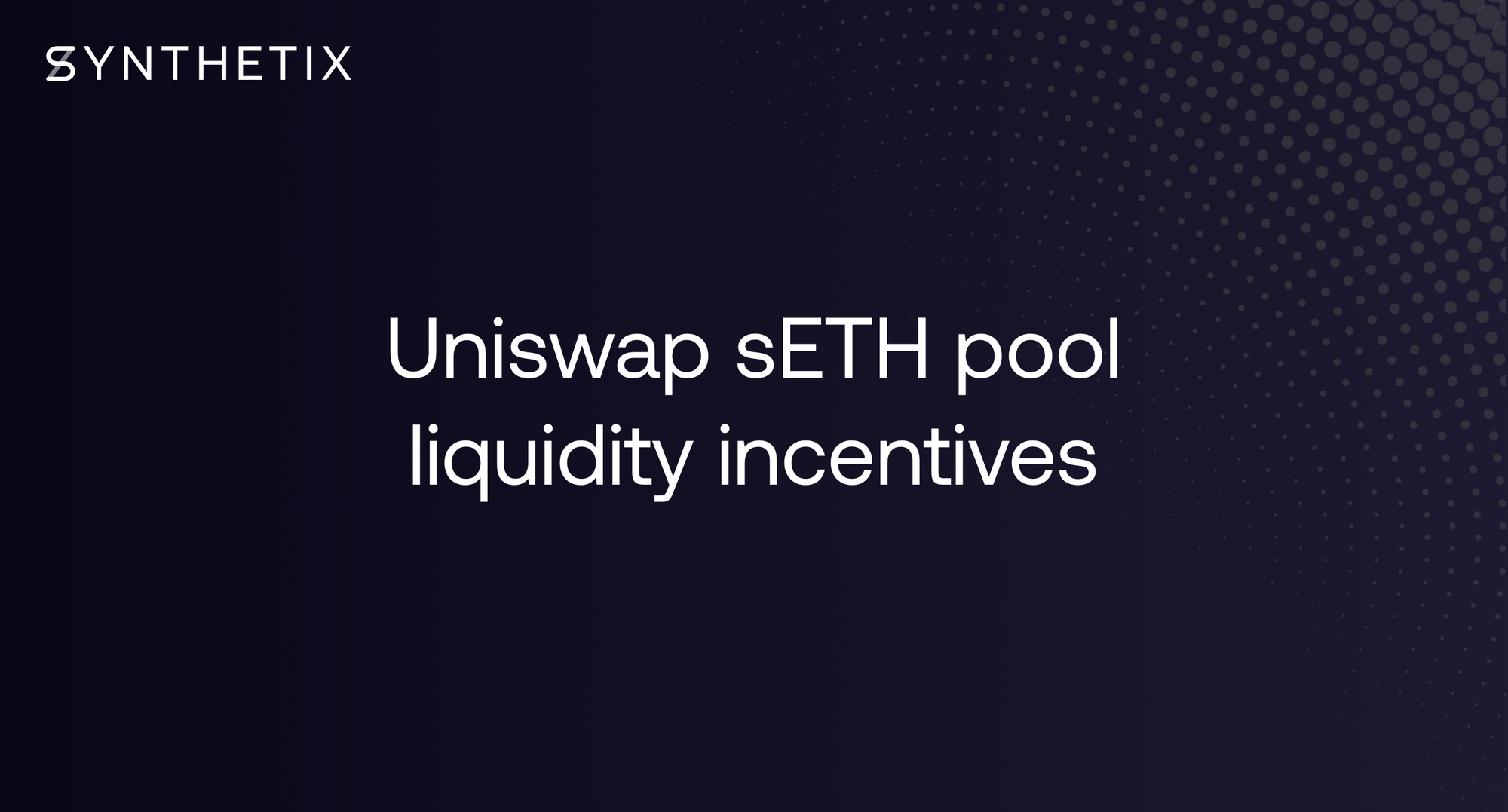Uniswap sETH Pool Liquidity Incentives
Our new initiative to incentivise an sETH/ETH liquidity pool on Uniswap

Please note (July 23, 2020): this incentive is now over — providing sETH liquidity on Uniswap is no longer rewarded.
It is no secret that we are huge fans of Uniswap. The ability for token holders to permissionlessly pool liquidity to enable a peer-to-contract trading experience for Uniswap users is extremely powerful. But being a liquidity provider on Uniswap is not risk free, so we believe there is an opportunity for projects to integrate Uniswap more deeply into their protocols and incentive designs. Today we are extremely excited to announce an experiment we will be running for the next four weeks to test whether protocol level incentives lead to a deep liquidity pool for the sETH/ETH pair on Uniswap.
Before describing the mechanics of the incentives it is worth explaining why we need this pool and how a sETH liquidity pool will improve the user experience on Synthetix.exchange. Think of Uniswap as a gateway into the Synthetix ecosystem, in order to trade on sX you need to have Synths, which right now typically means converting ETH into sUSD. Once you have Synths you can trade on sX and take advantage of the infinite liquidity mechanism allowing you to convert between Synths. What happens though, when you are done trading and want to exit the system back into ETH? Unfortunately there is a significant cost to exit the system as slippage on Uniswap is high and the exchange rate between sUSD/ETH typically trades at a discount of 5-10%.
A deep pool of liquidity enabling frictionless conversion between ETH and sETH will enable users to exit the system in a cost effective manner and provide confidence to in Synthetix.exchange. The trading experience and supported assets on sX already rivals most decentralised trading platforms, and this is just the beginning.
So why sETH/ETH rather than sUSD/ETH? The answer lies in observing the experience of liquidity providers to the WETH/ETH pool. Because these two assets should always trade at parity, and shifts in the price of ETH against USD do not require arbitrage, Arbitragers only need to ensure there is an equal amount of both assets and liquidity providers can collect trading fees for providing this service. But trading fees may not be sufficient..
How do we incentivise users to provide liquidity, when trading are not enough? The answer lies in our current staking rewards incentives. We currently pay SNX stakers staking rewards out of a weekly pool of SNX tokens created via inflation. These tokens are used as an incentive to drive the desired behaviour within the network, and they have been incredibly effective. Over 75% of the total SNX supply is currently staked. We want to test whether diverting some of these protocol level rewards to users staking sETH in Uniswap will be an effective incentive mechanism. The foundation will run a four week trial paying 5% of the weekly SNX staking rewards to holders of the Uniswap sETH pool token (~72k SNX tokens per week). If this experiment proves successful the next phase will be a submission of an SIP to the community to divert some of the inflationary rewards to this purpose moving forward. The current value of these SNX tokens is around $25,000 per week, so this should act as a powerful driver of this behaviour, and lead to a much better user experience within synthetix.exchange.
The specific distribution rules will be as follows:
1. SNX tokens will be distributed based on each wallet's percentage of the liquidity tokens in the pool at the end of each fee period.
2. You must be in the pool the entire week, from the start until the end (which means you need to add liquidity in the previous fee period), and no withdrawals are allowed. If you withdraw any liquidity, you will not receive any rewards at all for that week.
3. Only the opening LP token balance counts, you can add more liquidity but it will only be counted in following week.
4. Rewards will be distributed at some point in the following fee period. This can be a slow process, as we use a multisig wallet managed by a mixture of individuals from the team and community.
This experiment will hopefully demonstrate a new kind of composability within the DeFi ecosystem, where protocols can combine incentives across protocols to align incentives in a symbiotic and self reinforcing fashion. There is a lot of excitement about the potential for composability in DeFi, but we believe that we have barely scratched the surface in terms of how deep this might go in the future, with protocols using layered and self-reinforcing incentives across protocols to strengthen the entire ecosystem.
If you haven’t yet taken the time to learn how to provide liquidity on Uniswap you now have 72,000 reasons to learn! Here is a great article on how to get started.

